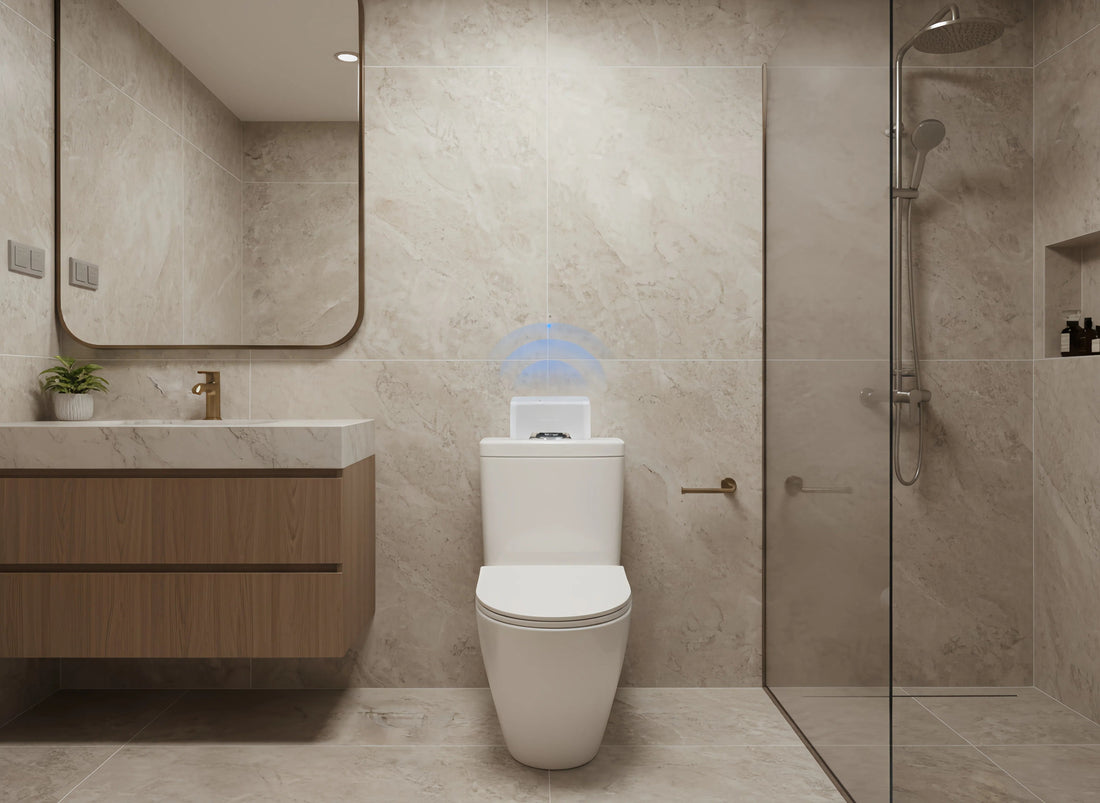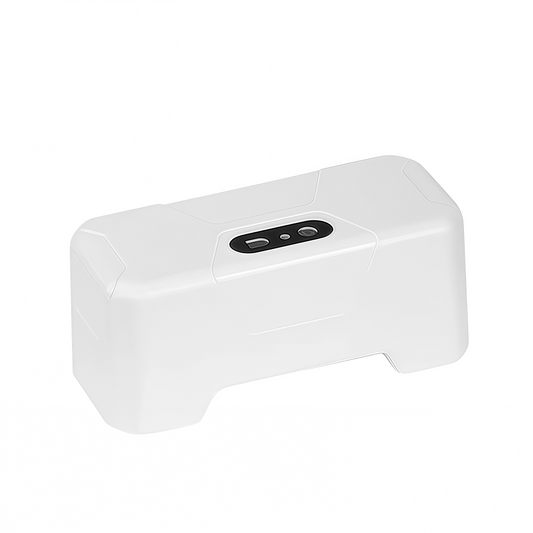
Why Do Automatic Toilets Flush Randomly?
Share
Automatic toilets are becoming more prevalent in public spaces, businesses, airports, and even some modern homes. While they offer convenience and a sense of hygiene, many people have experienced the rather frustrating phenomenon of automatic toilets flushing at seemingly random times. These unexpected flushes may occur while you're still sitting, standing, or even after you've left the stall. But why do automatic toilets flush randomly? In this article, we’ll break down the various reasons for this issue, explaining both the technical aspects of automatic flushing systems and the environmental factors that contribute to these unpredictable flushes.
Experiencing random flushes often? Consider upgrading to a more reliable system like our smart sensor flush kit designed for stable, no-false-trigger performance.
Understanding the Basics of Automatic Toilets
Before we dive into why automatic toilets flush randomly, it’s essential to understand how they work. Automatic toilets are equipped with a sensor system designed to detect the presence of a person. These sensors can detect body motion or heat, activating the flush mechanism once you leave the toilet seat.
Generally, the main components of an automatic toilet flush system include:
Infrared Sensors: Most common in modern automatic toilets, infrared sensors emit an infrared beam to detect movement, heat, or the presence of a user.
Pressure Sensors: Less commonly, toilets use pressure sensors embedded in the seat, which detect weight or pressure changes when someone sits down.
Ultrasonic Sensors: These use sound waves to detect movement or distance between the sensor and the object (usually a person) in front of it.
The system's goal is to automatically flush the toilet after use without requiring any user interaction. The sensors trigger the flush after a predetermined amount of time once they no longer detect the user’s presence.
Common Reasons for Random Flushing
1. Sensor Malfunction or Misalignment
Automatic toilets rely heavily on precise sensors. If a sensor is malfunctioning or misaligned, it can cause the toilet to flush at inappropriate times. For example:
Infrared Sensors: These sensors are supposed to detect the presence of a person sitting on the toilet. However, if the sensor is positioned too high or too low, it may pick up movement or even heat from surrounding objects like walls, doors, or even the user’s clothing, causing the toilet to flush randomly.
Pressure Sensors: If the pressure sensor embedded in the seat is faulty, it might incorrectly detect that someone is still sitting on the toilet, triggering the flush prematurely.
In many cases, a technician may need to recalibrate or replace these sensors to restore proper functionality.
2. Environmental Factors
Automatic toilets can be sensitive to their environment. Factors like lighting, temperature, and humidity can all affect sensor performance.
Bright Light Interference: Infrared sensors often operate by detecting heat signatures. In bright or fluctuating light conditions, such as during the day when sunlight is shining directly on the sensor, the sensor may misinterpret signals, thinking a user has moved away and activating the flush.
Heat Signatures: Automatic toilets are often designed to flush when they no longer detect a human presence. However, if there is another source of heat near the sensor—such as a heat vent or a running water pipe—it could mimic the heat signature of a person and trigger an unintended flush.
3. Motion Detection Errors
Automatic toilets commonly use motion detection sensors to determine when the user has finished their business. These sensors detect subtle shifts in motion or heat, which can be tricky.
Small Movements: Even small movements, such as adjusting your position on the seat, might trigger the motion sensor. For example, if you shift slightly or reach for toilet paper, the sensor may interpret these movements as the user leaving, prompting the toilet to flush.
Movement After Leaving: Many automatic toilets are set to wait a few seconds before flushing once no motion is detected. However, if the sensor is overly sensitive, it might register your movement as someone returning to the toilet, resulting in a random flush.
4. User Behavior or Seating Position
Your actions while using the toilet can also play a role in triggering an untimely flush. For example:
Standing Up Too Soon: If the sensor uses a combination of motion detection and pressure sensors, standing up too soon can sometimes lead to an unexpected flush, as the sensor might still detect your body weight or movement.
Adjusting the Seat: Shifting around or pressing on the toilet seat can momentarily affect the sensor’s ability to properly identify whether a person is still seated.
5. Low Battery or Power Issues
Automatic toilets rely on electronic components, and like any device, they can malfunction due to power issues. A weak battery or power fluctuations can cause erratic behavior in the sensor, including triggering random flushes. Our rechargeable auto-flush unit eliminates weak-battery malfunctions with a long-lasting charge and intelligent sensor calibration.
Battery-Operated Systems: In battery-operated systems, low battery voltage can cause the sensor to behave unpredictably. When the battery charge is running low, it may not process signals properly, leading to random flushes.
Power Surges: In systems that use a wired connection to the power grid, fluctuations in power supply or surges can interfere with sensor functionality, causing the flush system to misfire.
6. Flushing Timer Reset or Glitch
Many automatic toilets are programmed with a set timer, flushing the toilet after a certain period of inactivity. This ensures that the toilet doesn't remain unused indefinitely. If the timer malfunctions or is too short, it can cause the toilet to flush even if the user hasn’t finished their task.
Timing Glitch: A glitch in the system’s flush timer can cause random flushes. If the timer is triggered unexpectedly, or if there is a malfunction in the internal programming, it might force the system to flush when it shouldn't.
Sensor Delay: Sometimes the system may have a delayed response to your movements, meaning it flushes once you've left, but the sensor takes longer to register this movement, or it could flush while you’re still on the toilet, expecting you to leave sooner.
How Can Random Flushes Be Prevented?
Understanding why automatic toilets flush randomly can lead to better ways of managing the situation. Here are some steps that could help mitigate the issue:
Regular Maintenance and Calibration: Automatic toilets should be regularly inspected and calibrated to ensure the sensors are functioning correctly. A professional technician can ensure the infrared sensors, pressure sensors, and other components are properly aligned and working as expected.
Adjusting Sensor Sensitivity: Many modern automatic toilets allow users or maintenance personnel to adjust sensor sensitivity. If the toilet’s flushes seem too frequent or random, this can help reduce false activation.
Environmental Control: Ensuring that the area around the toilet is kept clear of bright lights or heat sources that could interfere with the sensor’s function can also help reduce false triggers. Keeping the bathroom well-ventilated may reduce the chances of the sensor picking up heat signatures incorrectly.
Improved Toilet Designs: Manufacturers are constantly improving the design and technology behind automatic toilets. Newer systems may use more advanced sensors or algorithms to detect and analyze user presence more accurately.
Tired of ghost flushes? Our auto toilet retrofit kit offers improved sensor stability and easy installation—ideal for high-traffic or home bathrooms.
Conclusion
While automatic toilets are designed to enhance convenience and hygiene, they can sometimes be plagued by the annoyance of random flushes. Understanding the underlying causes of this phenomenon—ranging from sensor malfunction and environmental factors to user behavior—can provide insight into why it happens. By ensuring that sensors are properly calibrated, adjusting for environmental factors, and maintaining the flushing system, these random flushes can be reduced, leading to a more pleasant and efficient restroom experience. Ultimately, the goal of automatic toilets is to provide comfort and ease, and with regular attention, they can function as intended.

